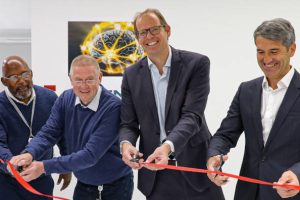
“An important challenge that has limited the scaling of integrated quantum photonics has been the lack of on-chip sources able to generate high-quality single photons,” according to Bristol quantum engineer Stefano Paesani.
Without low-noise photon sources, errors in a quantum computation accumulate with increasing circuit complexity, resulting in unreliable computation. Optical losses in sources also limit the number of photons the quantum computer can produce and process.
“In this work,” said Paesani, “we found a way to resolve this and in doing so we developed the first integrated photon source compatible with large-scale quantum photonics.
The team came up with what they call ‘inter-modal spontaneous four-wave mixing’ – where multiple modes of light propagating through a silicon waveguide interfere non-linearly.
According to the university, working with the University of Trento in Italy, the source was benchmarked for photonic quantum computing in a heralded Hong-Ou-Mandel experiment, a building block of optical quantum information processing, “and obtained the highest quality on-chip photonic quantum interference ever observed – 96% visibility”.
According to Paesani: “The device demonstrated by far the best performances for any integrated photon source: spectral purity and indistinguishability of 99% and > 90% photon heralding efficiency. Arrays of hundreds of these sources can be used to build near-term noisy intermediate-scale quantum [NISQ] photonic machines, where tens of photons can be processed to solve specialised tasks, such as the simulation of molecular dynamics or certain optimisation problems related to graph theory.”
The device is described in detail in Nature Communications paper ‘Near-ideal spontaneous photon sources in silicon quantum photonics‘, available free in full.
 The device, part buried under metal layers
The device, part buried under metal layers
In a nutshell, ~1550nm laser light is shone into one of the grating couplers, and used to emit entangled light particles (later collected from grating couplers just north of the image): a ~1588nm ‘signal’ photon and a ~1516 nm ‘idler’ photon.
In slightly more detail, after the laser energy arrives, it is split using a 50:50 beam-splitter.
One half or this gets converted into TM1 (transverse magnetic 1) mode in a waveguide, and other remains in its original (TM0) mode, but is delayed by ~1.5ps in a serpentine (see diagram). These two are combined by a mode converter (partially visible between two tracks) – launching the energy into a long multi-mode waveguide (spiralled into a letter-box rectangle in the image).
“Due to the different group velocities,” according to the paper, “the two modes become overlapped and subsequently diverge again while propagating through the source. Photon pairs are emitted via inter-modal spontaneous four-wave mixing and finally deterministically separated via a mode converter.” – a converter also just visible, form where they travel in separate waveguides to output grating couplers.
The research was funded by the Engineering and Physical Sciences Research Council (EPSRC) Hub in Quantum Computing and Simulation, and the European Research Council.
 Electronics Weekly Electronics Design & Components Tech News
Electronics Weekly Electronics Design & Components Tech News


